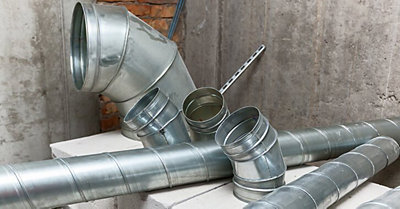Signs Of Poorly Installed Air Ducts | How To Identify Bad Ductwork

July 11, 2024
Even the most energy-efficient furnace, air conditioner, or other HVAC equipment can’t offset the effects of a bad ductwork installation. According to Energy Star, more than half of new ductwork systems don’t perform to their rated efficiency because of improper installation. This leads to high energy bills, reduced performance, sub-par indoor air quality, and poor air distribution.
Signs of a Bad Duct Installation
Poorly-installed and energy-inefficient ductwork can have numerous consequences for your system and impact its performance and longevity as well as your household’s comfort. See the signs of bad ductwork installation below.
High energy bills
Improperly installed ductwork is prone to leaks, and about 20% of the air that moves through the duct system escapes through gaps, holes, and poorly connected ducts. In response to leaky ducts, your HVAC system works harder to keep up with your home’s cooling needs. The excessive strain on your HVAC system translates to additional energy consumption and spikes in your energy bills.
Weak airflow
Check for weak airflow by inspecting the return and supply vents throughout your ductwork. Use a sheet of paper over the vent to test the strength of the air blowing from or into the vent — if it barely moves or appears weak, your ductwork may have gaps, flow-restricting bends or layouts, or other problems that cause pressure imbalances in your system.
Excessive noise
Pay attention to rattling, whistling, banging, or other abnormal sounds from your HVAC system. Turbulence throughout your system is a common result of poor connections, and the vibration can accelerate wear on fans, motors, and other parts of your HVAC system.
Poor insulation
Ductwork often requires insulation, especially in unconditioned areas such as crawl spaces, garages, basements, and attics where temperature differences can cause condensation to form. In addition to preventing condensation and associated mold and mildew air quality problems, ductwork insulation helps minimize heat transfer of both hot and cold air.
Insulation materials and thickness vary depending on climate, building codes, and other details. Service Champions uses advanced techniques and a variety of insulation materials, depending on the application and needs of your home. We work with fiber-reinforced mastic sealant,vapor barriers, and foil-backed insulation where needed. Our PureFlow™ Duct System technology ensures energy savings and strong airflow.
Frequent breakdowns
Poor installation can cause breakdowns and require frequent repairs. Many issues associated with bad ductwork lead to high strain on your HVAC or forced air unit, resulting in undue wear and damage on your system that can increase repair costs and decrease the service life.
Visible damage or problems
Look for cracks and gaps in the joints, seams, and connections of your ductwork. Holes in these areas increase air loss, higher energy consumption, and draw in dust, pollen, and other particles. Check any exposed vents for loose or detached sections, inconsistently sized vents, or other ductwork damage.
Poor air quality
Bad ductwork installation can contribute to poor air quality in your home. Ductwork leaks and gaps can compromise the effectiveness of air filters, allowing unfiltered air to bypass and cross-contaminate with clean air in the supply vents. This can be especially problematic if your ducts develop condensation, becoming an ideal habitat for mold and mildew, which then circulate spores throughout your home.
Uneven temperature
Hot and cold spots throughout your home often indicate issues with airflow. Tangled or improperly-sized ducts and blockages within the ducts can impede airflow and prevent your system from evenly heating or cooling your home, causing it to work harder than necessary to meet temperature settings. Your ductwork may also have poorly-sized or an insufficient amount of supply or return vents.

Professional Duct Maintenance, Repair, and Installation
If your ductwork system shows signs of a bad installation, a professional HVAC company will help you troubleshoot and form a customized solution.
A licensed HVAC technician ensures your ductwork operates in a fully-closed and tightly-sealed system with appropriate materials, layout, and insulation. They’ll pay attention to the small but crucial components of a ductwork system, such as:
Joints and seams sealed with mastic or similar material
Rigid metal for duct fittings
Pre-insulated duct fitting
Supported flex ducts
Open and unobstructed vents and registers
Once they’re finished the job, ask your HVAC technician to walk you through your system and conduct a visual inspection of their installations and repairs. Make sure all of the duct connections and joints seal properly with an approved sealant. Ask your HVAC technician to perform a duct leakage test before they leave.
Duct maintenance
Ductwork maintenance is essential for keeping up cooling and heating performance, energy efficiency, system longevity and reliability, and comfort year-round. Yearly HVAC tune-ups can help anticipate and address issues before they escalate into bigger problems. Regular ductwork maintenance can provide the following benefits:
Efficient airflow
Purified air
Mold and mildew prevention
Extended HVAC lifespan
Reduced repair costs
Peace of mind
Call Service Champions for Quality Ductwork Installation
Don’t let poor ductwork installation keep you from enjoying a cool and comfortable home during the sweltering California summer. Serving Alameda, Sacramento, and surrounding California areas for over 20 years, Service Champions is the go-to choice for your comprehensive home service needs.
From our maintenance plan to our competitive financing, our services come with a range of benefits. Enjoy 100% satisfaction in your ductwork repair or other services — contact us or book online today for your next service
Frequently Asked Questions
Can you install ductwork yourself?
While possible, DIY ductwork installation involves expert knowledge and intense physical labor. Leaving ductwork to the professionals can help ensure an efficient installation and avoid costly mistakes.
How long does ductwork last?
Ductwork can last between 10 and 15 years before the joints and seals start to weaken and lose efficiency. Regular maintenance, insulation, and other strategies can help extend your ductwork’s lifespan.
